Upgrades and improvements are coming to the Frederick Douglass Greater Rochester International Airport! As a result, there will be some minor disruptions and closures throughout the Airport campus. We apologize for the inconvenience, but are excited for the efficiencies and enhancements that will improve the passenger experience at ROC!

- Flights
-
Parking
- To & From
- At ROC
- About ROC
- ACDBE Notice
- Advertising Opportunities
- Airport Tours
- Airport Renaming Advisory Committee
- Air Cargo Facilities
- Annual Reports
- Aviation Services - Fixed Base Operators (FBO)
- Awards & Recognition
- Business Opportunities
- Construction & Planning
- Employment Opportunities
- Ethics Policy
- Federal Aviation Administration
- Flight Schools
- History & Statistics
- Long Term Tarmac Delay Plan
- Monroe County Airport Authority
- Minimum Standards for Commercial Aeronautical Activities
- National Air Carrier Association
- Noise Complaints
- Title VI Complaints
- Upcoming Projects
- Visit Rochester
- Accessibility
Art & Culture Exhibits
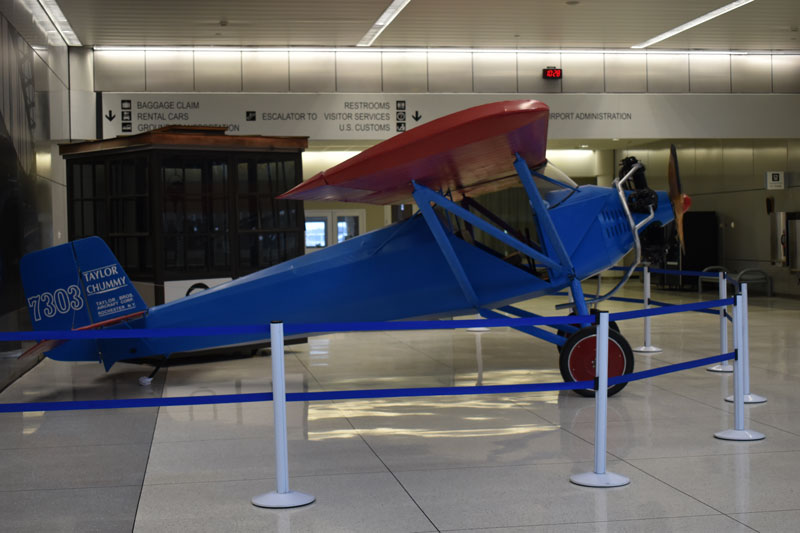 Taylor Chummy and Control Tower
Taylor Chummy and Control TowerA replica of the first aircraft that the Taylor Brother’s, well known aircraft manufacturer, ever built. Built originally in 1926, the replica on display in the airport terminal was built in 1998 by the Rochester Chapter of the Experimental Aircraft Association (EAA).
The control tower is typical of the first generation of Air Traffic Control Towers. It was commissioned in 1937 and served as the Air Traffic Control Facility for the Frederick Douglass Greater Rochester International Airport until 1948. It is dedicated to those early Air Traffic Controllers who pioneered air traffic safety and were the builders of the National Airspace system.
The Taylor Chummy and Control Tower are on display at the upper east end of the terminal ticketing lobby.
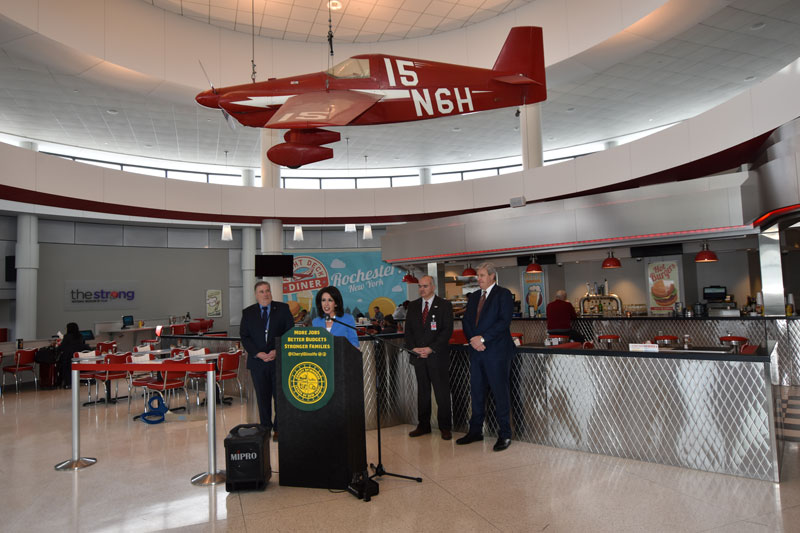 Ohm Special
Ohm SpecialAcquired from the Glenn Curtiss Museum in Hammondsport, New York, the Ohm Special, a homemade racing plane built in 1949 by Rochester native Dick Ohm is on display in the airport terminal. The local chapter of the Experimental Aircraft Association (EAA) restored the plane.
The plane is on display above the Flight Deck Diner located past security near Concourse A.
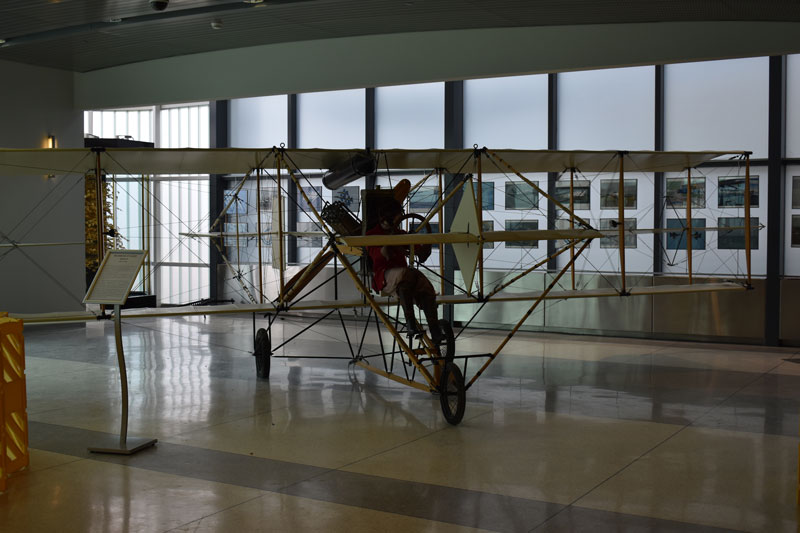 Curtiss Pusher 1911
Curtiss Pusher 1911Originally designed and built by Glenn Curtiss of Hammondsport, NY in 1911, the "Pusher" had a wingspan of 23 feet, 3 inches and was more than 25 feet long. It had a 8-cylinder, 40-hp engine, weighing in at 700 lbs. Unlike most propeller - driven aircraft, it was designed to be pushed by its propeller rather than pulled, hence the Curtiss "Pusher" name. The 1911 Curtiss Pusher was the very first aircraft to be flown on and off a shipof the US Navy and was also the first aircraft to be flown by a woman, Blanche Stuart Scott of Rochester, who is depicted in this display.
The plane is on display in the Public Airfield Observatory located at the upper west end of the terminal ticketing lobby.
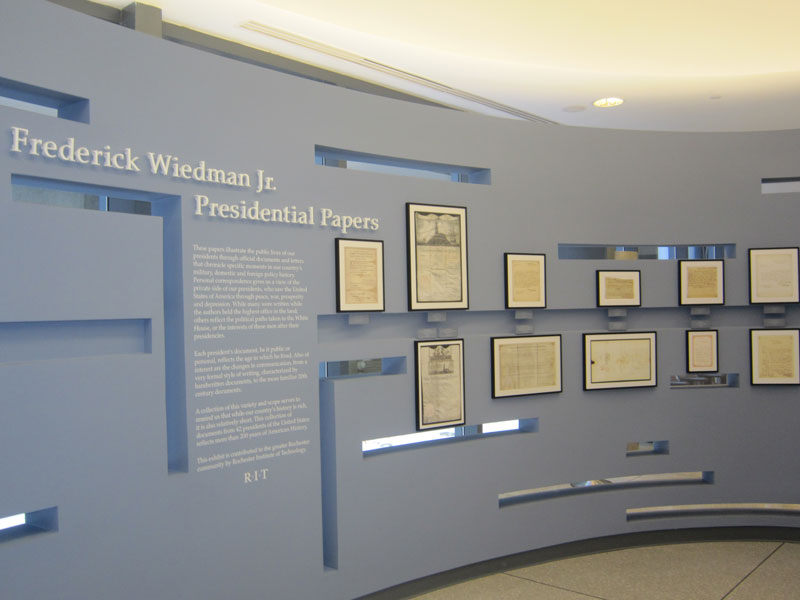 Presidential Papers Exhibit
Presidential Papers ExhibitThe Frederick Wiedman Jr. Collection of Presidential Papers
This exhibit made possible through a partnership of the Frederick Douglass Greater Rochester International Airport, Rochester Institute of Technology, and Frederick Wiedman Jr. is on display near the airport observatory. Frederick Wiedman Jr., who assembled this extraordinary collection, was a long-time Rochester attorney and supporter of Rochester Institute of Technology.
Spanning more than 200 years, the Frederick Wiedman Jr. Collection of Presidential Papers reflects the public lives of our former presidents through official moments in our country’s military, domestic and foreign policy history.
Ranging from a 1783 military discharge signed by George Washington to a personal letter from George Bush, the collection includes signed letters, documents and photographs from every U.S. President. Many of the documents are in the president’s own handwriting, and the collection includes letters from Abraham Lincoln, F.D.R. and John F. Kennedy and a personal letter commenting on the collection from Gerald R. Ford Jr. to Frederick Wiedman.
A collection of this variety and scope serves to remind us that while our country’s history is rich, it is also relatively short. In over 200 years, there have been just 43 presidents.
(This excerpt was take from the brochure that accompanies the exhibit in the terminal.)
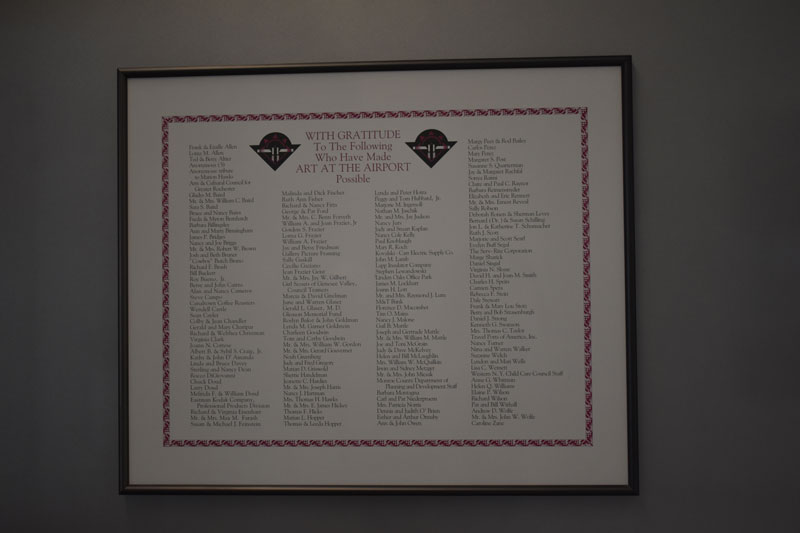 Rochester Public Art
Rochester Public ArtThe Monroe County Public Art Committee sponsored two competitions, in 1990 and 1991, to select seven works of art by Monroe County artists for the new Frederick Douglass Greater Rochester International Airport. The artists had been instructed to design works that consider a “sense of place,” a reference to western New York’s local history, industry, culture, and natural resources. Located on two airport levels and in the garage tower, the airport art welcomes people to the gateway of the community. Highlighting the creative energy of regional artists.
Completed in 1995, the projects from the second competition were funded by generous donations from private individuals and businesses. A plaque listing all donors is situated on the second floor of the terminal near the western escalator.
Thanks are due to the Monroe County Public Art Committee members for sharing their expertise throughout the two competitions, to the donors who made the project possible and to the airport administration, whose cooperation throughout the project made the installation of the projects successful.
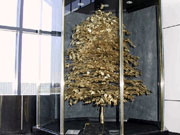 The Brass Tree
The Brass TreeThis one of a kind masterpiece is the creation of a local artist, restaurateur and inventor J. Pat Bucey.
Possessing a deep appreciation for nature, Pat was inspired by a maple tree that grew outside his bedroom window. The artist toiled three and one half years to finish this beautiful tree.
Five thousand brass leaves adorn the total brass trunk and twigged maple simile. The tree measures nine feet in height and seven feet in diameter and weighs almost 500 pounds. Each leaf and twig represents the hand craftsmanship and perseverance of this talented artist. With an appraised value of up to $100,000, it exemplifies the proud verse “Made in America.”
The tree was purchased in 1993 by Jasco Tools, Inc. to donate this work of art to the Frederick Douglass Greater Rochester Airport with the wish that our visitors and the citizens of Monroe County can share in its wonderful splendor.
Location: Upper West Main Terminal near the Frontier Business Terminal.
 The Monument
The MonumentBy Peter McGrain
A combination of traditional methods and space-age materials that spans nearly 100 feet. Monument deems to embrace the space it occupies, entrancing the viewer with its vivid linear suggestions of sequence and ascent. The use of “dichroic” glass, which shifts hues when viewed at different angles, adds a kinetic quality to the work.
Everything I have learned regarding the functional, aesthetic, structural, and political challenges one must consider when creating successful public artwork has come together in this project. It is my hope that Monument will stand as a shining, lasting example of the important role that appropriately conceived public art can play in enhancing the spirit and creative outlook within the community.
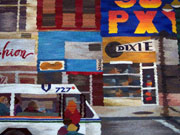 Bus Transfer By the Dixie Wig
Bus Transfer By the Dixie WigBy Ruth Manning
People instantly react to the warmth that tapestry gives the interior of a public building. Bus Transfer by the Dixie Wig was woven entirely by hand on a large, freestanding frame loom using the labor-intensive Gobelin tapestry technique. Hand-dyed yarns enable me to achieve the intense, wide-ranging color. Reflecting my interest in city imagery, this piece focuses on downtown. I chose this particular part of Main Street because it has remained unchanged and retained the character of the City of Rochester.
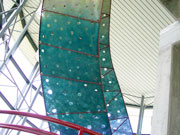 Airborne Stabile
Airborne StabileBy Susan Ferrari Rowley
Characterized by a linear quality that defines and implies the organization of space, my sculptures are clean and minimal, creating complex emotional tension through the placement and absence of elements. Airborne Stabile exhibits these same characteristics-its shape, scale, coloration, transparency, and placement make it visually accessible to pedestrians as they transcend the structure. It becomes one with the space, working with the sky beyond the atrium windows. The content is carefree, invoking the impression of flight.
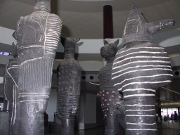 The Council
The CouncilBy Bill Stewart
Located in the Concourse B Rotunda
Terra Cotta, Glaze, Concrete, Granite & Water (1991)
Monroe County, NY Aviation Department
1200 Brooks Avenue, Rochester, NY 14624
Phone: 585 753-7000 · Fax: 585 753-7008Copyright 2024 - To & From
